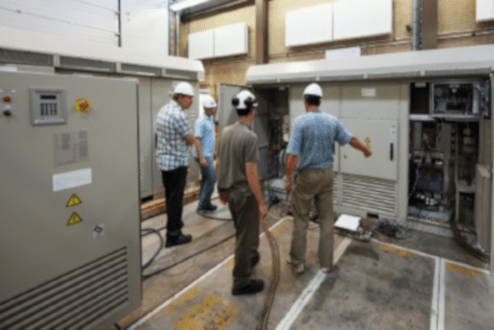
The Flex Power Grid Lab (FPGL) takes a unique position in the world because of its voltage capability (24kV,3Φ;50kV,1Φ), power range (1MVA) and bandwidth (2.4kHz). It builds on its long term experience of component research and testing in order to set the standard for future system validation research and testing.
Location: Arnhem, Netherlands

The Flex Power Grid Laboratory infrastructure is particularly well suited for research on, or testing of utility-interactive devices intended for low-voltage or medium-voltage distribution grids, such as power electronics converters, combined-heat & power (CHP) systems and storage systems. It features freely programmable, high-power AC and DC sources capable of realistically emulating a grid connection, a PV system, a storage system or a combination thereof. This enables extensive research and testing capabilities on aspects such as grid compliance – including fault-ride-through (FRT), interface protection and power quality (PQ) – functionality, component performance and component reliability.
Furthermore, the infrastructure incorporates real-time simulation capabilities to extend the research capabilities into the domain of Power Cybernetics as part of power system validation. A fully equipped measuring system is provided in the safety of the command-room. Moreover, the command room overlooks the laboratory floor on which the research objects are clearly visible but guarantees the user’s safety at all times.
One particular feature of this infrastructure that deserves special attention is its ability to influence the power quality of the AC distribution grid within the facility (AC grid simulator) to which the research equipment can be connected. It is possible to superimpose an arbitrary contribution of harmonic voltages on the grid voltage to simulate a badly polluted grid, or a badly polluted load (in reverse power flow direction). Dynamic network phenomena such as voltage and frequency variations can be realized with the ability to include voltage dips, phase jumps and rapid voltage changes, see Figure 1. The AC grid simulator is also capable of coping with unbalanced loads/sources and still provides the capability to superimpose harmonic voltages and instigate dynamic network phenomena for the purpose of interaction verification (equipment with grid under dynamic conditions) as well as component immunity and susceptibility analysis.
In essence there are two distinct operation modes available:
- First is the basic static operation mode with a fixed fundamental frequency (DC up to 75Hz), in which it is possible to superimpose a wide variety of harmonic distortions on top of the base frequency to simulate a badly polluted grid, or a badly polluted load (in reverse power flow direction). These amplitudes of the fundamental frequency, as well as that of the harmonics (voltage amplitude and angle of each individual harmonic individually controllable), can be varied online and are closed-loop controlled to a large extent.
- Secondly, there is the dynamic mode of operation. In this operation mode all kinds of other grid phenomena can be produced, e.g. voltage and frequency variations with the ability to include voltage dips, phase jumps and rapid voltage changes. The programmed grid is also capable of coping with unbalanced loads/sources and still provide the capability to superimpose harmonic voltages and instigate dynamic network phenomena onto it.
Finally, the laboratory is equipped with resistive (0.5MW), inductive (1MVAr) and capacitive (1MVAr) loads that are adjustable in a large range; and a connection to the utility grid with off-load tap changer (400V…4kV) to provide maximum flexibility for any research of testing endeavour.
The facility allows researchers to gain “hands-on” experience on the interaction of utility-interactive equipment, such as power electronics converters and its controls, with a distribution system and thereby fosters practical innovation in equipment technology within the power system industry.
Within the scope of the ERIGrid – Trans National Access activities, the FPGL research infrastructure offers the following services (for inspirational purposes, actual services can differ):
- Analysis, measurement and testing of (large scale) utility-interactive, power electronics equipment (inverters, battery storage systems, UPS systems, Vehicle2Grid and EV charging applications, active (harmonic) filters, STATCOMs, etc.) behaviour, in the development and deployment of advanced inverter functions, ancillary services, synthetic inertia, grid stability, etc
- Development, optimization, measurement and testing of (large-scale) smart grid operation and control algorithms based on distributed embedded control in power electronics equipment, for example.
- Individual conformance testing of utility-interactive power electronics equipment and evaluation of the performance of devices within a distribution system under different static and dynamic electrical conditions (efficiency, power quality , etc.), also as (part of) grid compliance initiatives.
- Analysis of system stability (large and small signal) in grids with a high penetration of power electronics equipment and/or controllers.
- Model validation of utility-interactive equipment and/or controllers within distribution grid applications.
Do you have questions left? Feel free to contact us below.
If your enquiry contains strictly confidential information, please leave your contact details below and the lab host will contact you personally.




